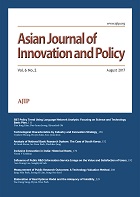A Comparative Study on Tenant Firms in Beijing Tsinghua University Science Park and Shenzhen Research Institute of Tsinghua University
Kazuyuki Motohashi (University of Tokyo)
Abstract
This paper aims to explore the institutional difference between Tsinghua University Science Park (TusPark) in Beijing, and business incubator of Research Institute of Tsinghua University in Shenzhen (RITS), and to examine how the difference leads to different new product performance for tenants. In doing so, we use survey methodology to investigate the innovation sources, university linkages, and innovation outputs of tenants in TusPark and RITS. We found that tenants in RITS reply more on “market-driven” knowledge sources for innovation: including knowledge from customers, suppliers, and competitors. The empirical findings suggest that the technology support provided by RITS and the high dependency on “market-driven” knowledge sources jointly contribute to the better new product performance for tenants in RITS.
- keywords
- University science park, business incubator, regional innovation system, innovative cluster, startup
참고문헌
Angel, D.P. (1991), High-technology agglomeration and the labor market: the case of Silicon Valley, Environment and Planning A, 23(10), 1501-1516.
Bramwell, A., and Wolfe, D.A. (2008), Universities and regional economic development: the entrepreneurial University of Waterloo, Research Policy, 37(8), 1175-1187.
Breschi, S., and Malerba, F. (2001), The geography of innovation and economic clustering: some introductory notes, Industrial and Corporate Change, 10(4), 817-833.
Bresnahan, T., Gambardella, A., and Saxenian, A. (2001), ‘Old economy’ inputs for ‘new economy’outcomes: cluster formation in the new Silicon Valleys, Industrial and corporate change, 10(4), 835-860.
Chan, K.F., and Lau, T. (2005), Assessing technology incubator programs in the science park: the good, the bad and the ugly, Technovation, 25(10), 1215-1228.
Chen, K., and Kenney, M. (2007), Universities/research institutes and regional innovation systems: the cases of Beijing and Shenzhen, World Development, 35(6), 1056-1074.
Coenen, L. (2007), The role of universities in the regional innovation systems of the North East of England and Scania, Sweden: providing missing links? Environment and Planning C, Government and Policy, 25(6), 803-821.
Cohen, W.M., Nelson, R.R., and Walsh, J.P. (2002), Links and impacts: the influence of public research on industrial R&D, Management Science, 48(1), 1-23.
Cooke, P. (2001), Regional innovation systems, clusters, and the knowledge economy, Industrial and Corporate Change, 10(4), 945-974.
Cooke, P., Uranga, M.G., and Etxebarria, G. (1997), Regional innovation systems: institutional and organisational dimensions, Research Policy, 26(4), 475-491.
Díez-Vial, I., and Montoro-Sánchez, Á. (2016), How knowledge links with universities may foster innovation: the case of a science park, Technovation, 50, 41-52.
Eesley, C.E., Yang, D., Li, T., and Roberts, E.B. (2016), Understanding entrepreneurial process and performance: a cross-national comparison of alumni entrepreneurship between MIT and Tsinghua University, Asian Journal of Innovation and Policy, 5(2),0.
He, J., Wang, L., and Zeng, G. (2013), Commercial exploitation of technical capacity promotes technology commercialization: a case from RITS. Studies in Science of Science, 31(9),0.
Löfsten, H., and Lindelöf, P. (2002), Science Parks and the growth of new technology-based firms-academic-industry links, innovation and markets, Research Policy, 31(6), 859-876.
Löfsten, H., and Lindelöf, P. (2005), R&D networks and product innovation patterns-academic and non-academic new technology-based firms on Science Parks, Technovation, 25(9), 1025-1037.
Li, Z., and Chen, H. (2014), Tsinghua University Science Park, Tsinghua University Press.
Lindelöf, P., and Löfsten, H. (2003), Science park location and new technology-based firms in Sweden-implications for strategy and performance, Small Business Economics, 20(3), 245-258.
Link, A.N., and Scott, J.T. (2003), US science parks: the diffusion of an innovation and its effects on the academic missions of universities, International Journal of Industrial Organization, 21(9), 1323-1356.
Link, A.N., and Scott, J.T. (2005), Opening the ivory tower's door: an analysis of the determinants of the formation of US university spin-off companies, Research Policy, 34(7), 1106-1112.
Motohashi, K. (2013), The role of the science park in innovation performance of start-up firms: an empirical analysis of Tsinghua Science Park in Beijing, Asia Pacific Business Review, 19(4), 578-599.
Phan, P.H., Siegel, D.S., and Wright, M. (2005), Science parks and incubators: observations, synthesis and future research, Journal of Business Venturing, 20(2), 165-182.
Porter, M.E. (2000), Location, competition, and economic development: local clusters in a global economy, Economic Development Quarterly, 14(1), 15-34.
Quintas, P., Wield, D., and Massey, D. (1992), Academic-industry links and innovation: questioning the science park model, Technovation, 12(3), 161-175.
Rothaermel, F.T., and Thursby, M. (2005), University-incubator firm knowledge flows: assessing their impact on incubator firm performance, Research Policy, 34(3), 305-320.
Saxenian, A. (1990), Regional networks and the resurgence of Silicon Valley, California Management Review, 33(1), 89-112.
Skarlicki, D.P., Folger, R., and Tesluk, P. (1999), Personality as a moderator in the relationship between fairness and retaliation, Academy of Management Journal, 42(1), 100-108.
Sohn, D.W., and Kenney, M. (2007), Universities, clusters, and innovation systems: the case of Seoul, Korea, World Development, 35(6), 991-1004.
Sun, W., Gao, J., Zhang, W., Wang, D., and Feng, G. (2009), Insititutional innovation for the industry - university - research institute collaboration: an integrated innovation unit, Science Research Management, 30(5),0.
Tan, J. (2006), Growth of industry clusters and innovation: lessons from Beijing Zhongguancun Science Park, Journal of Business Venturing, 21(6), 827-850.
Trippl, M., Sinozic, T., and Lawton Smith, H. (2015), The role of universities in regional development: conceptual models and policy institutions in the UK, Sweden and Austria, European Planning Studies, 23(9), 1722-1740.
Wang, L.H., Wang, C.W., and Zeng, G.P. (2013), Study of stratification mechanism in incubatees: case research Institute of Tsinghua University in Shenzhen, Forum on Science and Technology in China, 9(9),0.
Yang, C.H., Motohashi, K., and Chen, J.R. (2009), Are new technology-based firms located on science parks really more innovative?: evidence from Taiwan, Research Policy, 38(1), 77-85.
Zhao, S., Cacciolatti, L., Lee, S., and Song, W. (2015), Regional collaborations and indigenous innovation capabilities in China: a multivariate method for the analysis of regional innovation systems, Technological Forecasting and Social Change, 94, 202-220.
Zhou, Y. (2005), The making of an innovative region from a centrally planned economy: institutional evolution in Zhongguancun Science Park in Beijing, Environment and Planning A, 37(6), 1113-1134.
- 다운로드 수
- 조회수
- 0KCI 피인용수
- 0WOS 피인용수


